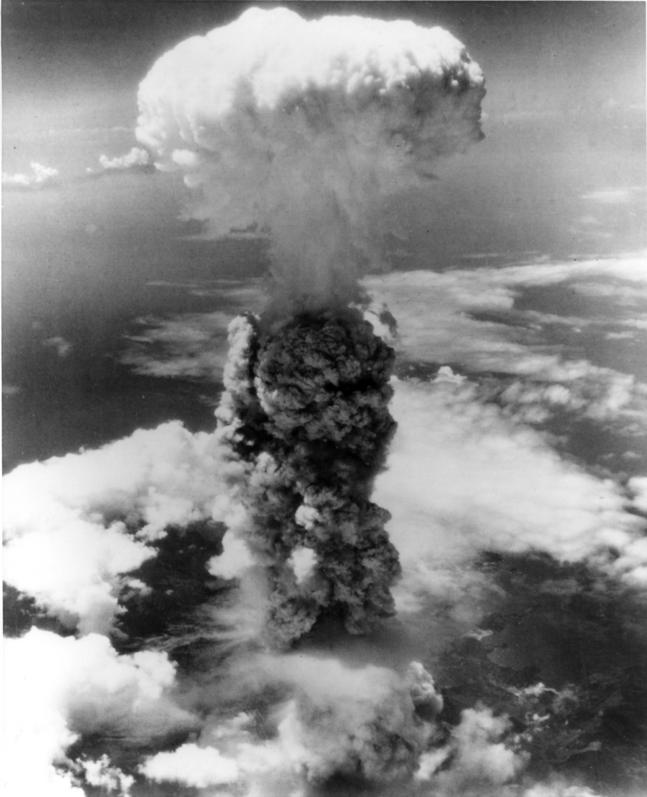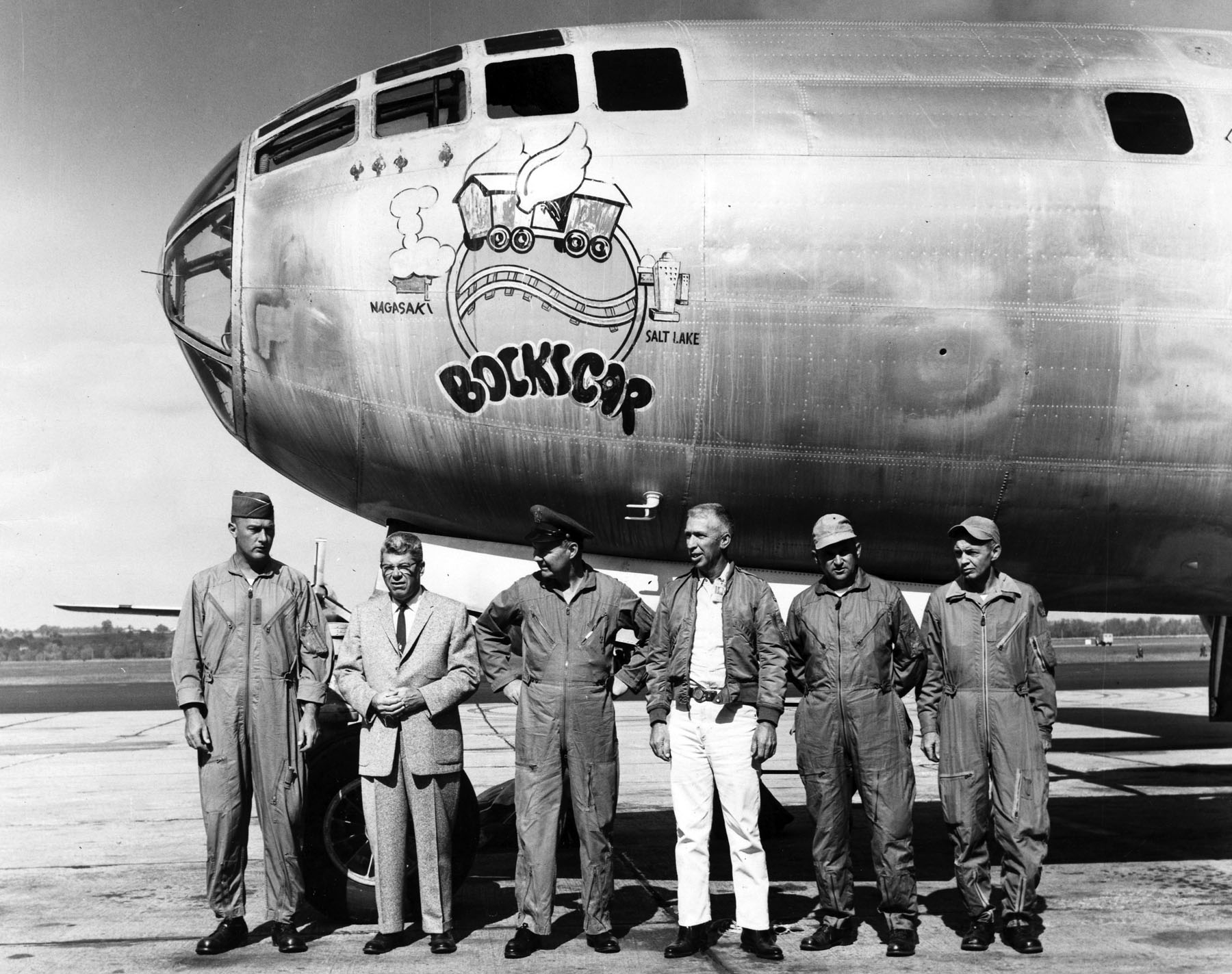WWII 75: Marching to Victory | August 9, 2020

WWII highlights from the Truman Library’s archives and collections
Marching to Victory: The Bombing of Nagasaki
August 9, 1945
Visitors to the Harry S. Truman Library and Museum can view a unique artifact that speaks to the revolutionary power and danger of the weapon that destroyed Nagasaki and helped end World War II.
Early in the morning on August 9, six B-29 bombers took off from an air base on the Pacific Island of Tinian. Major Charles W. Sweeney’s Bockscar carried “Fat Man,” a plutonium bomb of the type tested earlier at Alamogordo and more powerful than the uranium bomb dropped on Hiroshima.
Their target was the city of Kokura, home to one of Japan’s large ammunition arsenals. However, a bout of bad weather, spawned by a powerful typhoon, spelled doom for a different Japanese city.
In the summer of 1945, Nagasaki was a thriving city, still relatively untouched by the war, despite its shipyards and munitions factories. For the city’s quarter-million residents, that good fortune would be reversed in a mere 48 hours, beginning on August 7.
On that day, Japanese Emperor Hirohito received confirmation that the United States had leveled Hiroshima with an atomic bomb the day before. Despite the news, Hirohito and the Big Six, Japan’s Supreme War Council, refused to make peace. Japan would carry on the war, they determined, even should atomic bombs continue to devastate what remained of their cities. Not even news on August 9 that the Soviet Union was attacking in Manchuria caused Japan’s leaders to budge, and they enacted martial law to prevent any efforts at surrender.
Japan’s intractability prompted the U.S. high command to order Colonel Paul Tibbets, Jr. – leader of the Hiroshima mission – to carry out a second atomic bombing, this time on the city of Kokura. For months, Tibbets had coordinated with Manhattan Project personnel and trained his crewmen intensively for their top-secret mission.

Before taking off from Tinian, and ever mindful of Fat Man’s extreme danger, the crew of Bockscar kept the bomb’s two electrical safety plugs engaged as they lifted off the island. These green plugs were designed to prevent a detonation in the event of a crash on takeoff. Upon ensuring that all the plane’s engines were running smoothly, weaponeers Commander Frederick Ashworth and Lieutenant Philip M. Barnes replaced the green plugs with red safety plugs.
Fat Man was armed and ready for detonation.
However, when the airmen reached Kokura, they discovered that thick clouds and smoke obscured the city. With a fuel pump on Bockscar malfunctioning and Japanese antiaircraft fire getting closer, they decided to hit their secondary target – Nagasaki.
At 11 a.m., Sweeney and his crew arrived over their new target and released the bomb. It exploded with the force of 21 kilotons of TNT, destroying almost half of Nagasaki and instantly killing at least 35,000 people (with many more dying in the coming months).
Their mission complete, the B-29s headed for the American base at Iwo Jima, but the rapidly depleting fuel supply on Bockscar forced them to make an uncleared landing on Okinawa. Sweeney’s plane landed with two dead engines and only five minutes’ worth of fuel remaining.
That night, Emperor Hirohito and the Japanese cabinet met in Tokyo for a contentious debate on whether the time had come to surrender. Over the next few days, the Emperor would make his decision.
When the Harry S. Truman Library and Museum reopens later this year, visitors will be able to view a unique artifact that speaks to the revolutionary power and danger of the weapon that destroyed Nagasaki and helped end World War II: one of two green safety plugs from Fat Man, donated by Lt. Barnes to the Truman Library in 1988.
More to Explore
- Find more photos and documents related to World War II at TrumanLibrary.gov.
- Relive history in The White House Decision Center. Step back to 1945 and into the roles of President Truman, J. Robert Oppenheimer and other West Wing advisors. How will WWII end? You decide.
Marching to Victory
75 years ago, World War II ended under President Truman’s decisive leadership. Now, follow key events from the war’s final months with the Truman Library Institute’s series, “Marching to Victory: WWII Highlights from the Truman Library’s Archives and Collections.” The 25-part blog series opens the vaults at Truman’s presidential library to share eyewitness accounts and historic artifacts related to major conflicts and monumental victories – from the Battle of the Bulge to the liberation of Dachau to the unconditional surrender of Japan.
More in this series:
Marching to Victory: The Bombing of Dresden
Marching to Victory: The Yalta Conference
Marching to Victory: The Battle of the Bulge
Marching to Victory: The Tokyo Fire Raids
Marching to Victory: The Battle of Okinawa
Marching to Victory: The Liberation of Buchenwald
Marching to Victory: “The President is Dead”
Marching to Victory: The Liberation of Dachau
Marching to Victory: The Death of Adolf Hitler
Marching to Victory: Germany Surrenders!
Marching to Victory: Victory Gardens
Marching to Victory: Civil Rights
Marching to Victory: The United Nations
Marching to Victory: How Children Helped Win the War
Marching to Victory: The First Atomic Bomb Test
Marching to Victory: The Potsdam Conference
Marching to Victory: The Potsdam Declaration
Marching to Victory: The Bombing of Hiroshima
Contributed by Will Hickox, Ph.D. He has written for The New York Times and contributed to several digital history projects.
Join our email list to receive Truman updates right in your inbox:



